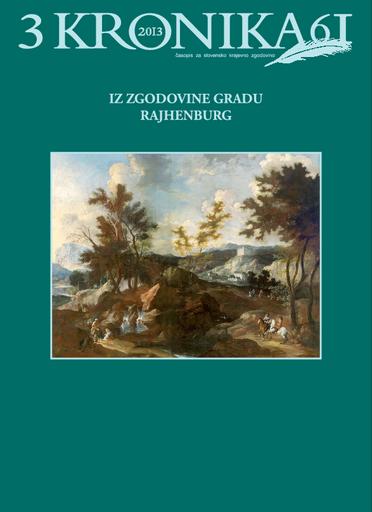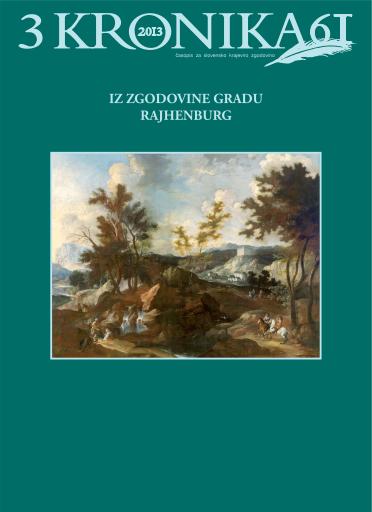/
Serijske publikacije
/
Kronika: časopis za slovensko krajevno zgodovino
Lastniki Rajhenburga med 16. in 19. stoletjem (1570–1881)

Avtor(ji):Lidija Slana
Soavtor(ji):Miha Preinfalk (odg. ur.), Barbara Šterbenc Svetina (teh. ur.), Alenka Cizel (prev.), Manca Gašperšič (prev.), Andreja Jankovič Deržič (prev.), Dejan Zadravec (prev.), Lidija Slana (prev.), Meta Osredkar (prev.), Agencija MultiLingual (prev.), Irena Bruckmüller Vilfan (prev.)
Leto:2013
Založnik(i):Zveza zgodovinskih društev Slovenije, Ljubljana
Vir(i):Kronika, 2013, št. 3
Jezik(i):slovenščina
Vrst(e) gradiva:besedilo
Ključne besede:Rajhenburg, Luknja, Brežice, plemiške rodbine na Štajerskem, Welzer, Egkh-Hungerspach, Gall-Gallenstein, Moscon, Attems, Heister, Waldburg-Zeil-Wurzach, Mandelstein, Delena, Esebeck, Rajhenburg (Reichenburg), Luknja (Luegg), Brežice (Rann), noble families in Styria, Welzer, Egkh- Hungerspach, Gall-Gallenstein, Moscon, Attems, Heister, Waldburg-Zeil-Wurzach, Mandelstein, Delena, Esebeck
Avtorske pravice:

To delo avtorja Lidija Slana je ponujeno pod Creative Commons Priznanje avtorstva-Nekomercialno-Brez predelav 4.0 Mednarodna
Datoteke (1)

Ime:kronika-2013_3.pdf
Velikost:66.73MB
Format:application/pdf
Stalna povezava:https://hdl.handle.net/11686/file18349
Opis
V prispevku so predstavljeni lastniki gradu in gospoščine Rajhenburg od leta 1570, ko se je končal rod vitezov
Rajhenburških in so dediščino prevzeli sorodniki Welzerji, za njimi baroni Egkh-Hungerspach, Gall-Gallensteini,
Mosconi, grofje Attemsi in drugi, vse do leta 1881, ko je pater Gabriel Giraud kupil grad in ga podaril meniškemu
redu trapistov.
Metapodatki (12)
- identifikatorhttps://hdl.handle.net/11686/34998
- naslov
- Lastniki Rajhenburga med 16. in 19. stoletjem (1570–1881)
- Proprietors of Rajhenburg between 16th and 19th Century (1570–1881)
- ustvarjalec
- Lidija Slana
- soavtor
- Miha Preinfalk (odg. ur.)
- Barbara Šterbenc Svetina (teh. ur.)
- Alenka Cizel (prev.)
- Manca Gašperšič (prev.)
- Andreja Jankovič Deržič (prev.)
- Dejan Zadravec (prev.)
- Lidija Slana (prev.)
- Meta Osredkar (prev.)
- Agencija MultiLingual (prev.)
- Irena Bruckmüller Vilfan (prev.)
- predmet
- Rajhenburg
- Luknja
- Brežice
- plemiške rodbine na Štajerskem
- Welzer
- Egkh-Hungerspach
- Gall-Gallenstein
- Moscon
- Attems
- Heister
- Waldburg-Zeil-Wurzach
- Mandelstein
- Delena
- Esebeck
- Rajhenburg (Reichenburg)
- Luknja (Luegg)
- Brežice (Rann)
- noble families in Styria
- Welzer
- Egkh- Hungerspach
- Gall-Gallenstein
- Moscon
- Attems
- Heister
- Waldburg-Zeil-Wurzach
- Mandelstein
- Delena
- Esebeck
- opis
- V prispevku so predstavljeni lastniki gradu in gospoščine Rajhenburg od leta 1570, ko se je končal rod vitezov Rajhenburških in so dediščino prevzeli sorodniki Welzerji, za njimi baroni Egkh-Hungerspach, Gall-Gallensteini, Mosconi, grofje Attemsi in drugi, vse do leta 1881, ko je pater Gabriel Giraud kupil grad in ga podaril meniškemu redu trapistov.
- The proprietors of the castle and seigneury Rajhenburg are represented in the contribution, since the year 1570, when the lineage of the knights of Rajhenburg died out and the heritage was taken over by their relatives the Welzer and then by the barons Egkh-Hungerspach, the nobles Gall-Gallenstein and Moscon, the counts of Attems and others, till the year 1881, when the friar Gabriel Giraud bought the castle and offered it to the religious order of Trappists.
- After the famous knights of Rajhenburg died out in 1570, there were here numerous proprietors of the castle and the seigneury, mostly the members of Styrian and Carniolian nobility. The members of the family Welzer were the heirs of the died out knights, referring to their right to inheritance by two marriages of their two female members, Margaret and Polyxene into the family Welzer, the first one in 1505 into the Styrian lineage, the second one in 1557 into the Carinthian lineage. The Styrian lineage Welzer received, besides the castle and the seigneury, the coat of arms of the Knights of Rajhenburg – the crowned blue wolf as well. Also the next proprietors of Rajhenburg, the Carniolean barons Egkh-Hungerspach were relatives of the extinct knights, and they decorated their coat of arms with the crowned blue wolf as well. But the family was protestant and the members had to emigrate to the German lands, so in 1603, the castle and the seigneury was sold to the noblewoman Afra Ambstatt, which sold it to her brother Franc Gall-Gallenstein immediately. He renovated the castle in the renaissance manner, but he never resided there, as he had a residence in the castle Brežice that was easier of access. He had numerous daughters and the heiress was one of them, Anna Catherine, married to Marquard Ursenpekh. Becoming widow, she sold the castle to her brother in law, Georg Christof Ursenpekh, she remarried in 1623 and bought it again. After her death in 1624, the heir was her second husband, John Jacob Attems, the first member of the numerous family Attems coming to settle in Styria. John Jacob Attems resided in the castle with his second spouse, Judith Maria Tattenbach, and in 1637, he sold the whole property to Anna Regina Breuner, the widow of his cousin and born countess of Wagensperg. The castle changed its proprietor already in two years. It was bought by Guy Jacob Moscon, which died in 1653 and the heir was his brother Jobst Joseph Moscon, the proprietor of the seigneury Sevnica. In 1680 the castle was bought by the count Hannibal Heister and in 1714 sold to the count Ignatius Maria Attems, the nephew of John Jacob Attems. In 1721, Ignatius Maria Attems bought the manor Turn under Rajhenburg from the estates of the land Styria and united it with Rajhenburg. Rajhenburg served to Ignatius Maria Attems and his heirs, the son Thaddeus, the grandson Joseph Bernard and the great-grandson Bernard Maria only for agricultural purposes; in this time, it was never furnished to enable a comfortable residence. In 19th century, there were some further proprietors, Aloysius Mandelstein from 1802 to 1820, Stephen and his son Ignatius Delena (only the castle without the incorporated manner Turn) from 1820 to 1855, Sidonia Brzozowska from 1855 to 1577. In 1577, a German count Eberhard Waldburg- Zeil-Wurzach bought and settled in Rajhenburg, but he had to leave it in 1865, as he took over the title of the prince in Wurzach. A couple of years, his cousin, the count Edmund Maldeghem lived in the castle, but he moved away in 1873 and in 1874, Rajhenburg was sold again. It was bought by the baron Christian Esebeck, which sold it in 1881 to Camille Giraud, the friar in the religious order of Trappists.
- založnik
- Zveza zgodovinskih društev Slovenije
- datum
- 2013
- tip
- besedilo
- jezik
- Slovenščina
- jeDelOd
- pravice
- licenca: ccByNcNd
